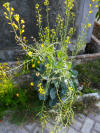WILD
FOODIES' HOME PAGE
PLANT PROFILE LIST
NAME: Mustard
SPECIES / FAMILY: Sinapis Arvensis / Brassicaceae
OTHER COMMON NAME(S): Wild Mustard, Field Mustard, Charlock
CONDITIONS: sun
|
PARTS: |
EDIBLE |
TASTE |
RAW/COOK |
SEASON |
|
All |
|
|
|
|
|
Shoots |
|
|
|
|
|
Leaves |
|
hot/mustard |
RAW/COOK |
Spring-Summer |
|
Flowers |
|
RAW/COOK |
Summer |
|
|
Fruits |
|
|
|
|
|
Roots |
||||
|
Seeds |
|
hot/mustard |
RAW/COOK |
Summer |
|
Nuts |
|
|
|
|
|
Pods |
|
|
|
|
|
Stalk/Stem |
|
|
|
|
|
Bark |
|
|
|
|
PORTION: small-medium
COMMENT: Soups, Salads, Pesto. Young leaves for salads, older leaves dried or cooked as herb. Flowers can be used to flavor wine or vinegar. “Flowering stems – cooked, a pleasant, cabbage/radish flavour, they can be used as a broccoli substitute before the flowers open. The stems should be lightly steamed for no more than 5 minutes. The flowers can also be cooked as a vegetable or used as a garnish. Seed - it can be sprouted and eaten raw. A hot flavour, it can be added to salads and sandwiches. The seed can be ground into a powder and used as a food flavouring. It has a hot mustard flavour. An edible oil is obtained from the seed.” (1)
CAUTION: Can cause irritation as with any hot and spicy food. Read “source” links below for cautions. "Many agricultural departments classify wild mustard as poisonous because if cattle eat too much of it they can get quite ill with stomach irritations — and they have more than one stomach to irritate. Humans aren’t the herbivores cattle are and we don’t tend to eat as much mustard, still some caution is advised. Many are allergic to mustard so if you’ve never eaten any, it is best to try only a little at first. Mustard is a bane to dairy cows because it can flavor the milk making it unsellable."(2)
NUTRITION/MEDICINAL: Bach. The plant is used in Bach flower remedies - the keywords for prescribing it are 'Black depression', 'Melancholia' and 'Gloom'. (1)
LOOK-A-LIKE & RELATED:
Yellow
Rocket
POISONOUS LOOK-A-LIKES: Senecio glabellus when young, https://en.wikipedia.org/wiki/Packera_glabella
OTHER USES: Oil; An edible semi-drying oil is obtained from the seed. It is also used in making soap[74] and burns well so can be used for lighting. (1)
SOURCE LINKS (may include nutritional and medicinal info, plus other uses):
- https://pfaf.org/user/Plant.aspx?LatinName=Sinapis+arvensis
- http://www.eattheweeds.com/cutting-the-wild-mustard-brassica-sinapis-2
- https://en.wikipedia.org/wiki/Sinapis_arvensis
- http://survivalweekly.com/719/wild-mustard
- https://commons.wikimedia.org/wiki/File:Wild_Mustard_Plant_Selective_Breeding.svg
- http://thecarrotrevolution.com/wild-foraging-cooking-with-wild-mustard


